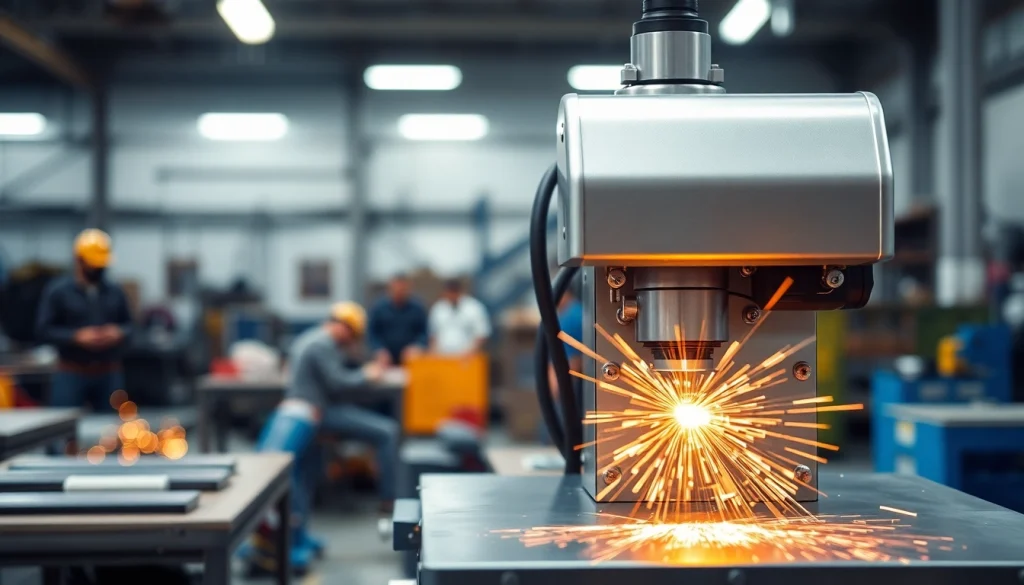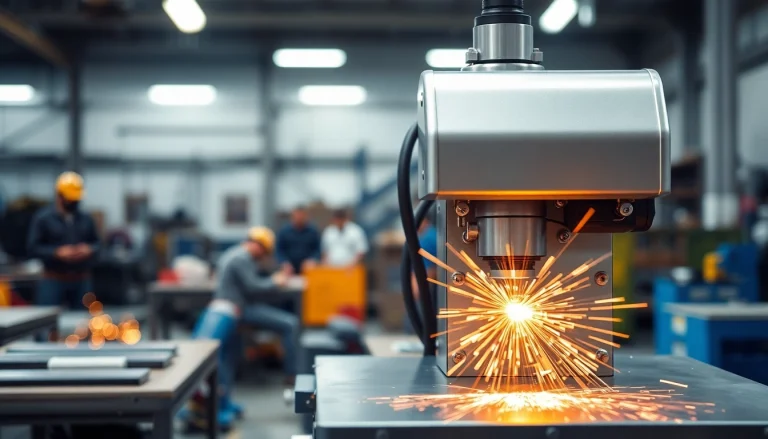
Understanding the Laser Welding Machine
What is Laser Welding?
Laser welding is a sophisticated joining process that employs the concentrated energy of a laser beam to fuse materials, typically metals. The laser creates a narrow and intense energy focus that penetrates the surfaces of the materials being joined, leading to minimal distortion and well-defined weld seams. This technique is favored across various industries for its precision and efficiency, making it a pivotal advancement in modern manufacturing.
How Does a Laser Welding Machine Work?
A laser welding machine operates by utilizing a laser beam to melt the workpieces’ edges. The key principle involved is the conversion of laser energy into heat to form a melt pool that solidifies upon cooling, effectively bonding the materials. The machine is equipped with intricate components to generate and manipulate the laser beam, directing it precisely at the joint area to create deep and narrow welds with consistent outcomes.
Key Components of a Laser Welding Machine
A typical Laser welding machine comprises several essential components:
- Laser Source: This is the core element that generates the laser beam. Various sources can be used, including fiber, Nd:YAG (neodymium-doped yttrium aluminum garnet), and CO2 lasers, each with different applications and characteristics.
- Beam Delivery System: This component includes optics and mirrors that guide the laser beam from the source to the workpiece, ensuring proper focus and alignment.
- Control System: It regulates the machine’s operation, including settings for power, speed, and movement. Advanced systems may include software for programming complex welding patterns.
- Workpiece Fixture: This part stabilizes the materials during the welding process to prevent movement that could affect the weld’s quality.
- Cooling System: A cooling mechanism is vital to dissipate excess heat and maintain the laser’s efficiency, prolonging the equipment’s lifespan.
Benefits of Using a Laser Welding Machine
Precision and Accuracy in Welding
Laser welding offers unparalleled precision, with the ability to achieve fine tolerances that are often unachievable with traditional welding methods. The focused energy allows for very fine welds, minimizing the heat-affected zones and reducing the need for extensive post-processing. This is especially important in industries where component integrity and precision are paramount.
Reduction of Heat-Affected Zones
One of the most notable benefits of laser welding is the reduced heat-affected zone (HAZ). The HAZ is the area surrounding the weld that can become weakened or altered in the metallurgical structure due to excessive heat exposure. Laser welding’s localized heat application results in a smaller HAZ, preserving the properties of adjacent materials and maintaining strength and durability.
Increased Production Speeds
Laser welding machines not only enhance the quality of welds but also significantly increase production speeds. The high energy concentration enables faster welding cycles, with some applications capable of producing continuous welds without interruption. This efficiency translates to lower operational costs and higher throughput for manufacturers.
Selecting the Right Laser Welding Machine
Types of Laser Welding Machines
When considering a laser welding machine, it is vital to understand the different types available:
- Fiber Laser Welding Machines: These machines are known for their efficiency and versatility, suitable for welding a variety of materials, including metals and plastics.
- Nd:YAG Laser Welding Machines: Commonly used in precision welding applications, Nd:YAG lasers are effective for thicker materials and provide excellent depth of penetration.
- CO2 Laser Welding Machines: These machines are primarily employed for cutting and welding non-metal materials but can handle thin metals under certain conditions.
Factors to Consider
Choosing the right laser welding machine involves considering several factors:
- Material Type: Different materials will require specific laser types and configurations for optimal welding results.
- Welding Thickness: The thickness of the materials to be welded plays a vital role in selecting the laser source and power settings.
- Production Volume: High-volume production may demand a more robust and faster machine, whereas lower-volume applications may benefit from a less expensive, smaller model.
- Environmental Considerations: Assessing the working environment is crucial, as some machines may require specific conditions, such as a clean room or controlled atmosphere.
Budgeting for Your Investment
Investing in a Laser welding machine can require a significant financial commitment. It’s essential to create a comprehensive budget that includes not only the machine’s cost but also operational expenses, maintenance, and potential training for operators. Additionally, researching financing options or leasing agreements may provide opportunities to access advanced technology without a substantial upfront investment.
Applications of Laser Welding Machines
Industries Utilizing Laser Welding
Laser welding is utilized across a spectrum of industries due to its versatility and efficiency. Some of the primary sectors include:
- Aerospace: Used for critical components that demand high strength and minimal weight.
- Automotive: Employed in the assembly of various automotive parts, enhancing performance and safety.
- Medical Devices: Essential for creating precise, sterile, and durable medical instruments.
- Electronics: Widely used for soldering and joining delicate electronic components.
Common Use Cases
Some common use cases of laser welding include:
- Joining thin-walled materials, such as sheet metal, without distortion.
- Welding intricate designs or complex geometries that traditional methods struggle to manage.
- Creating durable and high-strength bonds in demanding applications, such as in aircraft or automotive manufacturing.
- Facilitating speedy assembly in high-volume production lines.
Future Trends in Laser Welding Technology
As technology advances, several trends are emerging in the field of laser welding:
- Automation: The integration of robotics with laser welding systems is increasing efficiency and consistency while reducing human error.
- IoT Integration: Smart laser welding machines will leverage IoT technology for real-time monitoring and predictive maintenance, enhancing overall system reliability.
- Innovative Laser Types: New laser technologies, such as ultra-short pulse lasers, promise to expand the possibilities of laser welding in even more diverse material applications.
Maintenance and Operating Tips for Laser Welding Machines
Regular Maintenance Checklist
Maintaining a Laser welding machine is crucial for ensuring optimal performance and longevity. A regular maintenance checklist should include:
- Inspecting laser optics for cleanliness and alignment.
- Checking the cooling systems for proper function and fluid levels.
- Verifying all electrical connections and ensuring the software is up to date.
- Regularly cleaning and lubricating moving parts to prevent wear and tear.
Common Troubleshooting Issues
Even with proper maintenance, issues may arise. Common troubleshooting concerns include:
- Inconsistent weld quality, which may indicate misalignment of optics or worn-out components.
- Overheating, which can be due to flawed cooling systems or incorrect laser settings.
- Equipment downtime, often a result of mechanical failure or software malfunctions. Regular updates and proactive checkups can address these issues efficiently.
Best Practices for Users
To maximize the performance of their Laser welding machine, operators should adhere to these best practices:
- Receive comprehensive training on operating procedures and safety protocols.
- Regularly revisit and review machine settings to adapt to different materials and applications.
- Maintain clear communication with teammates to ensure coordinated operations, particularly in automated environments.
- Document each welding process and result for future reference and improvement. Analysis of data can lead to ongoing enhancements in efficiency and quality.






